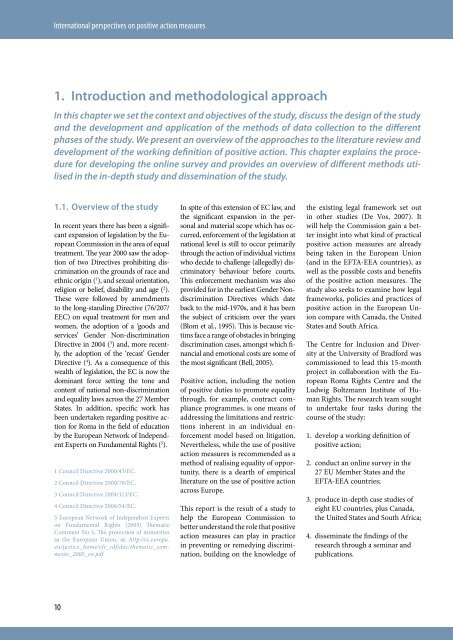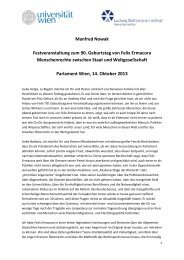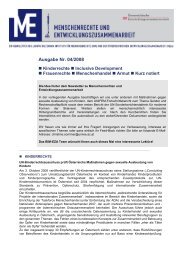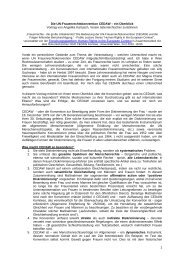International perspectives on positive action measures - European ...
International perspectives on positive action measures - European ...
International perspectives on positive action measures - European ...
You also want an ePaper? Increase the reach of your titles
YUMPU automatically turns print PDFs into web optimized ePapers that Google loves.
<str<strong>on</strong>g>Internati<strong>on</strong>al</str<strong>on</strong>g> <str<strong>on</strong>g>perspectives</str<strong>on</strong>g> <strong>on</strong> <strong>positive</strong> acti<strong>on</strong> <strong>measures</strong><br />
1.<br />
1.1. Overview of the study<br />
In recent years there has been a significant<br />
expansi<strong>on</strong> of legislati<strong>on</strong> by the <strong>European</strong><br />
Commissi<strong>on</strong> in the area of equal<br />
treatment. The year 2000 saw the adopti<strong>on</strong><br />
of two Directives prohibiting discriminati<strong>on</strong><br />
<strong>on</strong> the grounds of race and<br />
ethnic origin ( 1 ), and sexual orientati<strong>on</strong>,<br />
religi<strong>on</strong> or belief, disability and age ( 2 ).<br />
These were followed by amendments<br />
to the l<strong>on</strong>g-standing Directive (76/207/<br />
EEC) <strong>on</strong> equal treatment for men and<br />
women, the adopti<strong>on</strong> of a ‘goods and<br />
services’ Gender N<strong>on</strong>-discriminati<strong>on</strong><br />
Directive in 2004 ( 3 ) and, more recently,<br />
the adopti<strong>on</strong> of the ‘recast’ Gender<br />
Directive ( 4 ). As a c<strong>on</strong>sequence of this<br />
wealth of legislati<strong>on</strong>, the EC is now the<br />
dominant force setting the t<strong>on</strong>e and<br />
c<strong>on</strong>tent of nati<strong>on</strong>al n<strong>on</strong>-discriminati<strong>on</strong><br />
and equality laws across the 27 Member<br />
States. In additi<strong>on</strong>, specific work has<br />
been undertaken regarding <strong>positive</strong> acti<strong>on</strong><br />
for Roma in the field of educati<strong>on</strong><br />
by the <strong>European</strong> Network of Independent<br />
Experts <strong>on</strong> Fundamental Rights ( 5 ).<br />
1 Council Directive 2000/43/EC.<br />
2 Council Directive 2000/78/EC.<br />
3 Council Directive 2004/113/EC.<br />
4 Council Directive 2006/54/EC.<br />
5 <strong>European</strong> Network of Independent Experts<br />
<strong>on</strong> Fundamental Rights (2005) Thematic<br />
Comment No 3, The protecti<strong>on</strong> of minorities<br />
in the <strong>European</strong> Uni<strong>on</strong>, at: http://ec.europa.<br />
eu/justice_home/cfr_cdf/doc/thematic_comments_2005_en.pdf<br />
10<br />
Introducti<strong>on</strong> and methodological approach<br />
In this chapter we set the c<strong>on</strong>text and objectives of the study, discuss the design of the study<br />
and the development and applicati<strong>on</strong> of the methods of data collecti<strong>on</strong> to the different<br />
phases of the study. We present an overview of the approaches to the literature review and<br />
development of the working definiti<strong>on</strong> of <strong>positive</strong> acti<strong>on</strong>. This chapter explains the procedure<br />
for developing the <strong>on</strong>line survey and provides an overview of different methods utilised<br />
in the in-depth study and disseminati<strong>on</strong> of the study.<br />
In spite of this extensi<strong>on</strong> of EC law, and<br />
the significant expansi<strong>on</strong> in the pers<strong>on</strong>al<br />
and material scope which has occurred,<br />
enforcement of the legislati<strong>on</strong> at<br />
nati<strong>on</strong>al level is still to occur primarily<br />
through the acti<strong>on</strong> of individual victims<br />
who decide to challenge (allegedly) discriminatory<br />
behaviour before courts.<br />
This enforcement mechanism was also<br />
provided for in the earliest Gender N<strong>on</strong>discriminati<strong>on</strong><br />
Directives which date<br />
back to the mid-1970s, and it has been<br />
the subject of criticism over the years<br />
(Blom et al., 1995). This is because victims<br />
face a range of obstacles in bringing<br />
discriminati<strong>on</strong> cases, am<strong>on</strong>gst which financial<br />
and emoti<strong>on</strong>al costs are some of<br />
the most significant (Bell, 2005).<br />
Positive acti<strong>on</strong>, including the noti<strong>on</strong><br />
of <strong>positive</strong> duties to promote equality<br />
through, for example, c<strong>on</strong>tract compliance<br />
programmes, is <strong>on</strong>e means of<br />
addressing the limitati<strong>on</strong>s and restricti<strong>on</strong>s<br />
inherent in an individual enforcement<br />
model based <strong>on</strong> litigati<strong>on</strong>.<br />
Nevertheless, while the use of <strong>positive</strong><br />
acti<strong>on</strong> <strong>measures</strong> is recommended as a<br />
method of realising equality of opportunity,<br />
there is a dearth of empirical<br />
literature <strong>on</strong> the use of <strong>positive</strong> acti<strong>on</strong><br />
across Europe.<br />
This report is the result of a study to<br />
help the <strong>European</strong> Commissi<strong>on</strong> to<br />
better understand the role that <strong>positive</strong><br />
acti<strong>on</strong> <strong>measures</strong> can play in practice<br />
in preventing or remedying discriminati<strong>on</strong>,<br />
building <strong>on</strong> the knowledge of<br />
the existing legal framework set out<br />
in other studies (De Vos, 2007). It<br />
will help the Commissi<strong>on</strong> gain a better<br />
insight into what kind of practical<br />
<strong>positive</strong> acti<strong>on</strong> <strong>measures</strong> are already<br />
being taken in the <strong>European</strong> Uni<strong>on</strong><br />
(and in the EFTA-EEA countries), as<br />
well as the possible costs and benefits<br />
of the <strong>positive</strong> acti<strong>on</strong> <strong>measures</strong>. The<br />
study also seeks to examine how legal<br />
frameworks, policies and practices of<br />
<strong>positive</strong> acti<strong>on</strong> in the <strong>European</strong> Uni<strong>on</strong><br />
compare with Canada, the United<br />
States and South Africa.<br />
The Centre for Inclusi<strong>on</strong> and Diversity<br />
at the University of Bradford was<br />
commissi<strong>on</strong>ed to lead this 15-m<strong>on</strong>th<br />
project in collaborati<strong>on</strong> with the <strong>European</strong><br />
Roma Rights Centre and the<br />
Ludwig Boltzmann Institute of Human<br />
Rights. The research team sought<br />
to undertake four tasks during the<br />
course of the study:<br />
1. develop a working definiti<strong>on</strong> of<br />
<strong>positive</strong> acti<strong>on</strong>;<br />
2. c<strong>on</strong>duct an <strong>on</strong>line survey in the<br />
27 EU Member States and the<br />
EFTA-EEA countries;<br />
3. produce in-depth case studies of<br />
eight EU countries, plus Canada,<br />
the United States and South Africa;<br />
4. disseminate the findings of the<br />
research through a seminar and<br />
publicati<strong>on</strong>s.

















